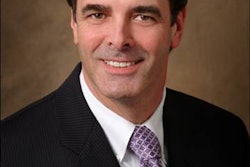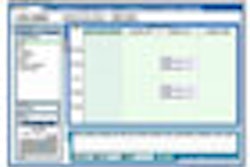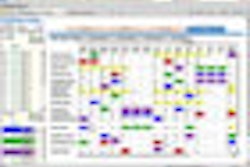I love the anonymity that the annual Healthcare Information and Management Systems Society (HIMSS) conference affords me. Unlike the RSNA meeting, where way too many people know me and a few even love me, at the HIMSS meeting I can go almost anywhere without being recognized and don't have to wear my bulletproof vest either -- yet.
My hometown of Orlando, FL, was once again host to the meeting this year. More than 900 vendors exhibited their wares, and well over 100 radiology-related systems such as PACS, RIS, speech recognition, digital dictation, and related components were shown.
Virtually all of the anchor (major) vendors had radiology systems, and nearly 25% of the total floor space at HIMSS 2008 was held by companies who play in the radiology space, including hardware vendors. This bodes exceptionally well for both the radiology community and HIMSS.
Why then, one has to ask, was it when searching the conference's Web site for educational sessions using keywords like PACS, radiology, imaging, RIS, storage, archives, etc., did I only come up with a total of three presentations (out of over 300), two of which were presented by vendors? The third presentation was about a specific product and was titled "Wireless Mobility -- Remote PACS Access in Your Pocket." That also made me think of Mae West's famous comment tweaked ever so slightly: "Is that a PACS in your pocket, or are you just happy to see me?"
The educational sessions, workshops, roundtable discussion, and symposia all seemed to skip PACS entirely. At a time when clinical decision-making, including PACS, is shifting from being radiology-centric to IT-centric, it begs the question, what do IT professionals really know about PACS?
More to the point, how will IT know if the decision being made by radiology is a good one for the organization if they don't know PACS from both a technology and functional standpoint? Is IT making PACS decisions using limited knowledge of the technical aspects or from a point of view that also incorporates operational needs? So many questions, so few answers.
One might also say that "All PACS are the same," but that holds about as much water as the argument that all men and all women are the same because of their genetic makeup. The reality is that IT often but, thankfully, not always makes PACS-related decisions based more on their comfort factor with the particular vendor(s) being considered by radiology than either the hardware being used or software applications.
The primary consideration should always be how the system being considered meets the radiology department's needs (including the need to service the primary care physicians and referral base), and, from a much broader sense, how well the system can be integrated into creating a computerized health record (CHR) somewhere down the road.
Doing a thorough PACS selection also requires a detailed understanding of radiology operations and requirements. From the technical side, IT needs to understand how the vendor supports DICOM, HL7, and the Integrating the Healthcare Enterprise (IHE) standards and associated transactions, profiles, objects, presentation states, etc.
This is where it gets a bit hairy. Most RFPs ask very basic questions, like "Do you support DICOM, IHE, HL7, etc.?" without getting into the meat and potatoes of the level of support each vendor provides. These generic questions don't provide the details necessary to allow IT to make informed, objective decisions. This brings me back full circle to the original question: How will IT managers, CIOs, CTOs, and others learn how to evaluate the area of PACS technology they are responsible for if their own society seems to ignore it?
A plethora of organizations and individuals, including myself, have offered to help educate the IT community, yet PACS-related educational proposals don't seem to have made it past the first cut at HIMSS meetings in recent years. There seems to be no reason for this, except that it could be assumed that IT already knows all it needs to about PACS, or that it is relying on the radiology and cardiology departments instead.
That would be an incorrect assumption. Like everything there are exceptions, but the majority of those in IT would probably freely admit they know little about PACS, and fewer still know where to get the information they need, except from vendors who are less than objective. Hopefully this will change in upcoming years.
It was fascinating to see the breadth and width of clinical offerings the radiology vendors, especially the major vendors, actually have. At RSNA the focus is, as one would expect, on radiology products, yet at HIMSS the variety and quality of products from the vendors exhibited exceptionally well.
Some of the CIOs and CTOs I chatted with also felt that while many of the smaller independent vendors seemed to have very solid solutions, the challenges of integration often exceeded the value of implementing these "best of breed" offerings. That's a shame because many of the independents have great solutions.
Standards
This comes back to having standards that are both easy to understand and implement. Unfortunately, with HL7 a possible exception, the current standards fail miserably in terms of educating the end users. Compounding these challenges is the fact that most individuals within the IT world are overwhelmed with other projects; learning the basics about standards just isn't a top priority.
So what is the answer then? Hire a consultant? No, not always or even at all. If anything, the number of consultants who offered their "expert services" at HIMSS was mind-boggling -- at least 40 at last count. What we need instead is a standardized checklist of sorts that outlines not just a vendor's compliance from a global standpoint but one that addresses in detail their support of transactions, profiles, associations, and the like.
That way the end user can decide what is and isn't important from their perspective. In addition, this may also avoid the situation of going through an image data migration, only to find the data isn't easily migrated or that certain things like annotations and the creation of study montages can't be transferred over to the new PACS.
These are the things that IT is tasked with handling: the technical aspects of PACS versus the functional and operational. Yet without the proper tools and knowledge of all the requirements, it is difficult, if not impossible, to do the job. HIMSS, the Society for Imaging Informatics in Medicine (SIIM), RSNA, or other organizations would be wise to create a vendor evaluation toolkit that can be updated monthly and disseminated to those performing PACS evaluations.
The number of electronic medical record (EMR) systems shown was astounding, second only to the American Health Information Management Association (AHIMA) meeting for medical records professionals. Interestingly, virtually none of the vendors offering EMR seemed to address the storage of medical images, only documents. This is still relegated back to the handful of vendors in the radiology realm.
On the positive side, a few new additions in radiology storage did appear at HIMSS, including some interesting offerings from the storage-area network (SAN) players. Without question, incorporating offsite archives with disaster recovery and data migration will be the biggest area of growth in the healthcare IT field involving medical imaging.
Just a few new additions joined the general radiology playing field, with a notable one coming from a small Redmond, WA-based company that controls 98% of the operating systems used in the world. Its booth was packed, but the story line and product integration was not yet nearly as cohesive or understandable as others.
Cardiology PACS
It was interesting to see that many of the PACS players were also exhibiting cardiology PACS (C-PACS), although product offerings varied widely from vendor to vendor. Some just offer static color image capture and playback, while others captured real-time 30 frames-per-second video, as well as waveform and audio files.
Up until now C-PACS has been a fairly slow market for a plethora of reasons, but with costs dropping and the level of integration rising among all clinical systems, you may start to see growth pick up.
Hardware vendors provided the most levity, with absolutely no love shown between the two major competing firms in the PACS arena. Several of the independent PACS providers have partnership arrangements with one vendor, while a few have announced relationships with the other. Meanwhile, the majority of the market is remaining fairly agnostic or is playing both sides against the middle by having arrangements with both.
Even among those who remain agnostic or have arrangements with both, establishing a vendor of choice or identifying one as the default vendor is pretty much standard. Unfortunately, my line of questioning with one of the hardware vendors about the use and selection by PACS providers wasn't well received by the "farmer" I chatted with in this vendor's booth.
When I told them that hardware selection was basically done by default unless otherwise requested and that many of the vendors they identified as their OEMs had their competitor's hardware as the default, you would have thought I called their kid ugly. They also have no clue how the decisions on hardware are made, expecting some complex formula to rule the decision instead of the templated approach used by many vendors today.
On the plus side, I learned a lot about genome sequencing. On the minus side, I had no absolutely no idea what the heck that had to do with our conversation about PACS hardware selection. It seems when you come from one market into another and your back is seemingly against the wall, you fall back to what you know best. That seems to be where this person's area of expertise was.
I can also share with you my newfound knowledge that a genome sequence contains more than 3 terabytes worth of data, so the next time you are at a party or trying to impress a date, share that factoid with them. Better yet, if you really want to impress them, you can drop names like lymphedema-cholestasis syndrome, Joubert syndrome, or paroxysmal kinesigenic dyskinesia. Just don't let them know there are only nine active medical sequencing projects going on in the National Human Genome Research Institute's Large-Scale Genome Sequencing Program (NHGRI-LSGSP -- that's a mouthful) or you'll look kinda silly.
Peripherals
I fully expected to see the complement of systems vendors -- lab, pharmacy, pathology, financial, scheduling, etc. -- and did, almost to extremes. So many vendors, so little time, but a few of the peripheral vendors took me by surprise. Workstation furniture and DVD writers I expected, but I never really equated waterproof keyboards as a hot commodity. They apparently are, though, in both the emergency room and operating room. I did have to question though why a wheel vendor was at an IT show, but hey, stranger things have happened.
It's also interesting to see how some companies will try and make money by protecting their "interests" by patenting what amounts to middle C on the piano. That seems to be the case relating to a patent infringement case issued just days before HIMSS, this time involving medical CD/DVD creation using embedded DICOM viewers.
Many of the smaller players in the CD/DVD creation market I saw at HIMSS were understandably on edge here, unsure what to do since no details were provided by the patent owner other than a cease-and-desist order. Meanwhile, the majors are basically yawning at it all, having been here many times before, most recently addressing a patent infringement case a few years back that involved hanging protocols. That dispute ended in a stalemate.
If recollection serves me well, that may be the same situation here, as both DICOM viewers and removable media existed prior to the initial patent claim date. Most of these David and Goliath cases also end when David realizes that fighting Goliath takes a lot more than a lucky shot with a stone to win the case and that the big boys do indeed own the quarry. The little guys usually settle before the owner takes on the big guns -- and that seems to be the strategy employed here -- but it should be fun to watch it evolve ... as long as the legal costs are not coming out of my pocket. I'm cheering for the little guys, because we all need to work together, not try and tear a market apart.
Overall HIMSS is a great show to provide a snapshot of where clinical IT systems are and where they are going in healthcare. I was impressed by what I saw, but still feel there's a critical need for education in the IT community. From what I could tell from those I chatted with in the IT community, they feel the same way as well.
I'm not sure I'll be at the HIMSS conference next year in Chicago. Somehow the thought of this Floridian heading back to McCormick Place a mere three months after the RSNA show really doesn't appeal to me, but then again you never know.
With any luck I may be asked to revive a 90-minute presentation I gave years ago, titled "Everything IT Needs to Know About PACS (But Is Afraid to Ask)." It attracted a fair number of people considering it was given when PACS didn't have nearly the draw it does now. The offer is on the table to HIMMS -- if you want it, I'll do it for free, even if it means sacrificing Florida's 70° temperatures for Chicago's 30s. Going once ... going twice ... do I hear a bid?
By Michael J. Cannavo
AuntMinnie.com contributing writer
March 10, 2008
Michael J. Cannavo is a leading PACS consultant and has authored nearly 300 articles on PACS technology in the past 16 years. He can be reached via e-mail at [email protected].
The comments and observations expressed herein do not necessarily reflect the opinions of AuntMinnie.com, nor should they be construed as an endorsement or admonishment of any particular vendor, analyst, industry consultant, or consulting group. Rather, they should be taken as the personal observations of a guy who has, by his own account, been in this industry way too long.
Related Reading
Part XVII: Exploring PACS Secrets -- The state of the PACS market, 2008, February 7, 2008
The 2007 PACSman Awards: Great expectations, November 29, 2007
Part XV: Exploring PACS Secrets -- The eHarmony approach, August 1, 2007
Part XIV: Exploring PACS Secrets -- Reading the fine print, March 12, 2007
Copyright © 2008 AuntMinnie.com



















